The RadioHead
life. technology. experiences
Friday, February 25, 2005
Thursday, February 24, 2005
Secure Gmail Access
If you're a frequent Gmail user like me, you would've noticed that Gmail provides secure [encrypted] login while the rest of the pages are blatantly unsecure. Using it in public wireless networks allows anyone on that network to access all the emails that you send and recieve. A simple way to secure your Gmail data transfers from prying eyes is to use https which is nothing but http layered over SSL (secure sockets layer).
The default login will take you to your inbox and the session remains unsecure. It looks as follows -
Using https directs the message to a secure port address rather than the default Web port number of 80. Your Firefox browser will show the address bar turn pale yellow indicating a secure site.

So the next time you decide to browse at your local wifi-enabled Barista or Starbucks, make sure you have your Gmail session secured.
[via stopdesign]
Thursday, February 17, 2005
The Pop Fan Theory!
Disclaimer - The following post is about a theory that has been giving the author sleepless nights for the past few days. The research and statistics are purely hypothetical and are not attributed to anything on the web or elsewhere. Cynics and people who cant understand good humor are forewarned.
We all use so many products in our lifetime that it becomes too difficult to keep count. Not that it really matters, but it does gives you an idea of the kind of evolution that we tend to take for granted. Take for example - cars. I remember way back when I was little, the kind of cars that kissed the road were very different from those that we see today. They were rather boxy in shape and "beauty" was a word that only a rare breed had the privilege of being called. If you look at cars today, they are trendier, a whole lot more attractive and technologically more advanced. So, the whole "product evolution" thingie makes for an interesting study. The same can be applied to shoes, watches and almost everything that you can think of.
But have you ever wondered about one product thats so ubiquitous and almost spans a lifetime. Yes, the fan!
I've always wondered how fan manufacturers make their money. Its interesting because you almost never replace a fan. Majority of the people buy fans (the ceiling variety in particular) while constructing or renovating buildings. Some of these are also passed on to future generations. So that actually gives very little scope for these manufacturers to make any money. Lets do a little hypothesis to understand the situation better - say of the 1.02 billion people in India, about 30% of these stay in cities and the rest 70% in villages. Out of that 70%, say 50% of them have pucca houses and have access to electricity. Putting down the relevant numbers and doing the arithmetic , you'll find thats its a very small percentage. And for a product that usually lasts a lifetime, it can be a cause of worry for the manufacturers. So, how do these manufacturers survive? Well, it really simple - apply "The Pop Fan Theory", which is as follows..
The Pop Fan Theory [beta 0.1] states that the construction of buildings is proportional to the rise in population which inturn creates the need for more fans.
In other words...
Rise in population = more homes = need for fans = more sales
Inference : If you want to sell more fans, increase the population!
Well, I'm not going to delve into how these faceless manufacturers are conspiring the "increasing population" bit, lest I get into any political turmoil. However, feel free to add to the TPFT and refine it.
Tuesday, February 15, 2005
Googlee
The RadioHead now provides tiffin services. Atleast, thats what Google 'thinks'..
Update: They seem to have realised their folly!
Thursday, February 10, 2005
The ATM Experience
Tea time is when we at work relax, kick off our shoes and talk about stuff which are usually non-work related. The general conversation revolves around things currently in news or about some experience that one of us had over the weekend. Interestingly enough, our topic today was ATM - no, not the one thats got to do with mathematics, but the Automated Teller Machine.
Visiting the ATM these days has become quite an ordeal. More often than not, you would end up waiting in a long queue. I've been using the ATM for the past couple of years and have had my share of experiences. This particular bank that I'm talking about (and I'm sure others would follow suit), has two teller machines close to my office and is usually crowded during business hours. A typical scene at the ATM is as follows -
- You go to the ATM with an urgent need for cash only to find a queue that snakes a mile long.
- You decide to wait in the queue after learning that the nearest ATM of the same bank is about 4 blocks away.
- While waiting at the queue you notice people cutting in - joining their friend/colleague/spouse who is standing ahead of you. You control your anger by biting your jaw.
- Almost half way through, you realize that one of the teller machines is not working. The two line queue reorganizes into one at the blink of an eye. You look at your watch and calculate how much longer you'd have to wait. You force yourself to be calm and chew another polo.
- After waiting for what seems like ages, you have finally one person in front of you when you see the other teller machine up and running. Your brain starts computing enormous differential algorithms and you finally decide to stick to the same queue.
- The person in front completes his transaction and you proceed to the teller. You gently push the ATM card into the slot and and enter your transaction details. The teller processes it and displays the following message -
Sorry! Your transaction cannot be completed. Please try again later.
- You gather your wits, cancel the transaction, eject your card and try again. People behind start giving you all sorts of looks. You also notice the speed at which the other line starts moving. You are reminded of Murphy's Laws. You enter the PIN code slowly this time, making sure you've entered them right and wait. You get the same message.
- You turn around and ask the person behind you to try his card. You step aside so that he can enter his PIN code. He gets the same message. We conclude that the teller has no money in it and make an announcement for the others.
- You turn to the second line and request the person whose turn is next to let you in after having explained your situation. He agrees and you thank him profusely.
- You proceed to the teller machine, complete your transaction, thank the person once again and leave.
The current process can be listed as follows -
- Insert card.
- Select language.
- Enter pin.
- Choose transaction option.
- Enter details (amount).
- Receipt? (yes / no).
- Withdraw cash
- Another transaction? (yes / no)
- Collect receipt.
- Collect card (beeps)
- If the user selects English as language, it should set that as default and quit asking the next time. (one key stroke less).
- I've got the habit of withdrawing the same amount over 90% of the time, so it should allow for dispensing that amount (checking from transaction history) at the click of a single button rather than having me (the user) to enter the amount again. (3 or more key strokes less)
- I've noticed slightly taller (6 feet and above) people having to bend down to look at the screen. This can be avoided by having configurable screen settings for individual users. So, certain users can have the screen tilt or the display height adjusted automatically when they insert their card into the machine. This returns to default state when the transaction is completed. Needless to say, the same goes for people of shorter height.
- The display is also difficult to look at under certain lighting conditions especially outdoors. They could have sensors installed that automatically adjust display settings according to the ambience.
- The ATM display could also do with better graphics. Motion graphics (flash) that fade-in and fade-out quickly can be quite pleasing to the eyes.
- The teller could also display the available (or unavailable) currency denominations in the machine on user authentication. This will also alert the user before hand as to the available denominations in which he can withdraw.
- A contact-less smart {proximity} card that stores vital information and configuration settings in encrypted format. This would result in longer card life and also allow the user to activate the teller without having to take the card out of the wallet.
Wednesday, February 09, 2005
I've been busy the last few days shifting to a new place after having looked around for almost 2 weeks (thats also a reason for the lack of posts). A good friend and I have taken this small crib on top of a fairly new building and we've got the terrace all by ourselves. Its always a great feeling to move to a new place and set things up the way you want to. More updates soon.
Friday, February 04, 2005
Wednesday, February 02, 2005
MSN Relaunched!
Microsoft has finally given the MSN homepage a cosmetic enhancement, this time complying with web standards. A lot of XHTML validation done here. Whats significant is that they have adopted CSS based table-less layouts and thats definitely a major improvement. However, the overall layout is still disappointing. One, the whole page looks a little cluttered (in Firefox atleast) giving a sense of unprofessionalism for a high profile site like MSN. And two, there is way too much similarity with Yahoo's search bar (pointy tabs).
However, this is not to say that MSN cant compete with the others in this domain. With a little more time spent on improving the interface and optimizing search algorithms, MSN can give Google (or Yahoo for that matter) a run for their money!
Update [Feb 8th, 2005] - MSN Arabia looks a lot better!







